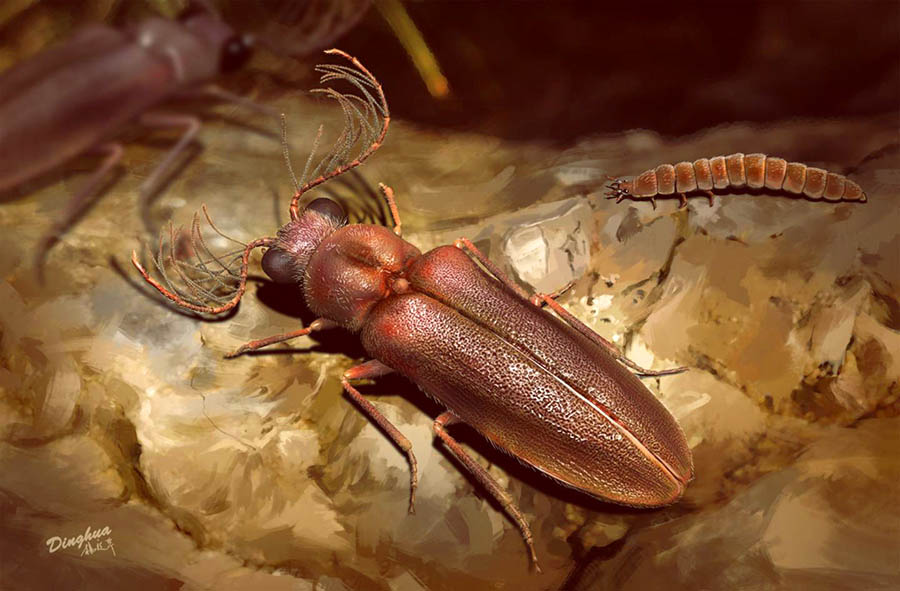Cretophengodes azari: 99-Million-Year-Old Bioluminescent Beetle Found Preserved in Amber

Found in a piece of mid-Cretaceous amber from northern Myanmar, the wonderfully-preserved male of Cretophengodes azari has a light organ on the abdomen which presumably served a defensive function.
Bioluminescence, the production of light by living organisms, evolved over 30 times independently on diverse branches of the tree of life including algae, cnidarians, fishes and marine worms.
On land, light-producing beetles are the most widespread and abundant bioluminescent organisms. Their elaborate flash displays play a role in mate recognition as well as in signaling, communication and luring prey.
The majority of these beetles — over 2,300 species — belong to the megadiverse superfamily Elateroidea (fireflies, fire beetles, glow-worms).
The evolution of bioluminescence in these beetles is associated with unusual morphological modifications, such as soft-bodiedness and neoteny (delaying or slowing of the physiological development), but the fragmentary nature of their fossil record discloses little about the origin of these adaptations.
“Most light-producing beetles are soft-bodied and quite small, and so have a scant fossil record,” said Dr. Chenyang Cai, a researcher in the School of Earth Sciences at the University of Bristol and the Nanjing Institute of Geology and Palaeontology and the Centre for Excellence in Life and Palaeoenvironment of the Chinese Academy of Sciences.
“However, the new fossil, found in amber from northern Myanmar, is exceptionally well-preserved, even the light organ on its abdomen is intact.”
“Elateroidea is one of the most heterogeneous groups of beetles and that has always been very difficult for entomologists to deal with, particularly because important anatomical innovations evolved many times independently in unrelated groups,” said Dr. Erik Tihelka, a researcher in the School of Earth Sciences at the University of Bristol.
“The discovery of a new extinct elateroid beetle family is significant because it helps shed light on the evolution of these fascinating beetles.”

A specimen of Burmese amber with Cretophengodes azari came from amber mines near the Noije Bum Hill in Myanmar’s Kachin State.
The ancient beetle was so unique that the researchers created a new family, Cretophengodidae, for it.
“The unique combination of characters in Cretophengodes azari is unknown in any currently defined beetle lineage,” they said.
“Therefore, Cretophengodes azari deserves family status in Elateroidea.”
Cretophengodes azari also represents a transitional fossil linking soft- and hard-bodied elateroid beetles.
“The newly-discovered fossil, preserved with life-like fidelity in amber, represents an extinct relative of the fireflies and the living families Rhagophthalmidae and Phengodidae,” said Dr. Yan-Da Li, a researcher at Peking University and the Nanjing Institute of Geology and Palaeontology and the Centre for Excellence in Life and Palaeoenvironment of the Chinese Academy of Sciences.
“We think that light production initially evolved in the beetle’s soft and vulnerable larvae as a defensive mechanism to ward off predators.”
“The fossil shows that by the Cretaceous period, light production was taken up by the adults as well,” said Dr. Robin Kundrata, a researcher in the Department of Zoology at Palacký University.
“It could have than been co-opted to serve other functions such as locating mates.”
The findings were published in the Proceedings of the Royal Society B.
_____
Yan-Da Li et al. 2021. Cretophengodidae, a new Cretaceous beetle family, sheds light on the evolution of bioluminescence. Proc. R. Soc. B 288 (1943): 20202730; doi: 10.1098/rspb.2020.2730
Source: www.sci-news.com/








